Inequality in China’s Food and Nutrition Production and the Decomposition of Contributing Sources
Abstract
1. Introduction
2. Literature Review
3. Data and Methods
3.1. Data
3.2. Methods
3.2.1. Calculation of Nutrition Production
3.2.2. Calculation of Concentration and Inequality Indexes
3.2.3. The Decomposition of Inequality of Food and Nutrition
- (1)
- Decomposition by geographical group
- (2)
- Decomposition by food categories
4. Results
4.1. The Centralization of Food and Nutrient Production
4.2. The Inequality of Food and Nutrition Production
4.3. The Decomposition of Inequality of Food and Nutrition Production
5. Discussion
5.1. Links Between Food and Nutrition Production Inequality
5.2. The Driving Factors Behind Changes in Food and Nutrition Production Inequality
5.3. Policy Implications
6. Conclusions and Limitations
Author Contributions
Funding
Institutional Review Board Statement
Informed Consent Statement
Data Availability Statement
Conflicts of Interest
References
- Huang, L.; Wang, Z.; Wang, H.; Zhao, L.; Jiang, H.; Zhang, B.; Ding, G. Nutrition transition and related health challenges over decades in China. Eur. J. Clin. Nutr. 2021, 75, 247–252. [Google Scholar] [CrossRef] [PubMed]
- Yu, S.; Bai, X.; Zhao, J.; Zeng, Y.; Wang, Y.; Wang, Z.; Wang, L.; Shi, Z. Mismatch between provincial grain production and consumption increased cropland soil erosion in China. Agric. Ecosyst. Environ. 2024, 367, 108999. [Google Scholar] [CrossRef]
- Zhao, H.; Chang, J.; Havlík, P.; Van Dijk, M.; Valin, H.; Janssens, C.; Ma, L.; Bai, Z.; Herrero, M.; Smith, P.; et al. China’s future food demand and its implications for trade and environment. Nat. Sustain. 2021, 4, 1042–1051. [Google Scholar] [CrossRef]
- Wang, X.; Qiang, W.; Niu, S.; Growe, A.; Yan, S.; Tian, N. Multi-Scenario Simulation Analysis of Grain Production and Demand in China during the Peak Population Period. Foods 2022, 11, 1566. [Google Scholar] [CrossRef]
- Wang, Q.; Yue, T.; Wang, C.; Fan, Z.; Liu, X. Spatial-temporal variations of food provision in China. Procedia Environ. Sci. 2012, 13, 1933–1945. [Google Scholar] [CrossRef][Green Version]
- Campi, M.; Dueñas, M.; Fagiolo, G. Specialization in food production, global food security and sustainability (No. 2020/05). In LEM Working Paper Series No. 2020/05; Scuola Superiore Sant’Anna, Laboratory of Economics and Management (LEM): Pisa, Italy, 2020; Available online: https://www.econstor.eu/handle/10419/228144 (accessed on 3 September 2025).
- Qi, Y.; Qiang, W.; Ma, X. Spatiotemporal Pattern Evolution of Food and Nutrient Production in China. Foods 2023, 12, 3791. [Google Scholar] [CrossRef]
- Van Zutphen, K.G.; Van Den Berg, S.; Gavin-Smith, B.; Imbo, E.; Kraemer, K.; Monroy-Gomez, J.; Pannatier, M.; Prytherch, H.; Six, J.; Thoennissen, C.; et al. Nutrition as a driver and outcome of agroecology. Nat. Food 2022, 3, 990–996. [Google Scholar] [CrossRef]
- Wang, J.; Zhang, Z.; Liu, Y. Spatial shifts in grain production increases in China and implications for food security. Land Use Pol. 2018, 74, 204–213. [Google Scholar] [CrossRef]
- Remans, R.; Wood, S.A.; Saha, N.; Anderman, T.L.; DeFries, R.S. Measuring nutritional diversity of national food supplies. Glob. Food Secur. 2014, 3, 174–182. [Google Scholar] [CrossRef]
- Masters, W.A.; Hall, A.; Martinez, E.M.; Shi, P.; Singh, G.; Webb, P.; Mozaffarian, D. The nutrition transition and agricultural transformation: A Preston curve approach. Agric. Econ. 2016, 47, 97–114. [Google Scholar] [CrossRef]
- Downs, S.M.; Fox, E.L. Uneven decline in food system inequality. Nat. Food 2021, 2, 141–142. [Google Scholar] [CrossRef]
- Bodirsky, B.L.; Dietrich, J.P.; Martinelli, E.; Stenstad, A.; Pradhan, P.; Gabrysch, S.; Mishra, A.; Weindl, I.; Le Mouël, C.; Rolinski, S.; et al. The ongoing nutrition transition thwarts long-term targets for food security, public health and environmental protection. Sci. Rep. 2020, 10, 19778. [Google Scholar] [CrossRef] [PubMed]
- Campi, M.; Dueñas, M.; Fagiolo, G. Specialization in food production affects global food security and food systems sustainability. World Dev. 2021, 141, 105411. [Google Scholar] [CrossRef]
- D’Odorico, P.; Carr, J.A.; Davis, K.F.; Dell’Angelo, J.; Seekell, D.A. Food inequality, injustice, and rights. BioScience 2019, 69, 180–190. [Google Scholar] [CrossRef] [PubMed]
- Li, E.; Zhu, J.; Li, X. Geographical agglomeration and specialized pattern of planting in China based on the different classifications. Prog. Geogr. 2012, 31, 1063–1070. (In Chinese) [Google Scholar]
- Wang, F.; Liu, Y.; Kong, X.; Chen, Y.; Pan, J. Spatial and temporal variation of grain production and its influencing factors at the county level in China. Econ. Geogr. 2018, 38, 142–151. (In Chinese) [Google Scholar]
- Wang, W.; Xiang, Y.; Qi, C. Study on geographic agglomeration of fruit industry in China: Spatial-temporal characteristics and affecting factors. Econ. Geogr. 2013, 33, 97–103. (In Chinese) [Google Scholar]
- Xue, L.; Zhang, W.; Yang, C. The production concentration shift of China’s specialty oil crops and the influencing factors. Res. Agric. Mod. 2019, 40, 755–763. (In Chinese) [Google Scholar]
- Wang, G.; Wang, M.; Yang, C. Characteristics and mechanism of animal husbandry’s geographical agglomeration in China. J. Nat. Resour. 2014, 29, 2137–2146. (In Chinese) [Google Scholar]
- Wang, G.; Wang, M.; Wang, J.M. Spatial-temporal dynamics and its influencing factors of herbivorous livestock breeding in China. Acta Geogr. Sin. 2015, 70, 1091–1100. (In Chinese) [Google Scholar]
- Zhou, X.; Yan, Z.; Shi, Y. Analysis on the Layout of China’s pig production transition: Based on the spatial Gini Coefficient and Barycenter Theory. Chin. J. Anim. Sci. 2020, 56, 214–219+225. (In Chinese) [Google Scholar]
- Ghose, B. Food security and food self-sufficiency in China: From past to 2050. Food Energy Secur. 2014, 3, 86–95. [Google Scholar] [CrossRef]
- Zhang, H.; Zhang, W.; Lu, Y.; Wang, Y.; Shan, Y.; Ping, L.; Li, H.; Lee, L.; Wang, T.; Liang, C.; et al. Worsening Carbon Inequality Embodied in Trade within China. Environ. Sci. Technol. 2023, 57, 863–873. [Google Scholar] [CrossRef] [PubMed]
- Liu, J.; Yang, H.; Savenije, H. China’s move to higher-meat diet hits water security. Nature 2008, 454, 397. [Google Scholar] [CrossRef]
- Ju, H.; Liu, Y.; Zhang, S. Interprovincial agricultural water footprint in China: Spatial pattern, driving forces and implications for water resource management. Sustain. Prod. Consump. 2023, 43, 264–277. [Google Scholar] [CrossRef]
- Liao, Z. The Analysis of Basic Public Service Supply Regional Equalization in China’s Provinces—Based on the Theil Index Evaluation. IOP Conf. Ser. Earth Environ. Sci. 2017, 100, 012106. [Google Scholar] [CrossRef]
- Oswald, Y.; Owen, A.; Steinberger, J.K. Large inequality in international and intranational energy footprints between income groups and across consumption categories. Nat. Energy 2020, 5, 231–239. [Google Scholar] [CrossRef]
- Tian, Q.; Zhao, T.; Yuan, R. An overview of the inequality in China’s carbon intensity 1997–2016: A Theil index decomposition analysis. Clean Technol. Environ. Policy 2021, 23, 1581–1601. [Google Scholar] [CrossRef]
- Duro, J.A.; Teixidó-Figueras, J.; Padilla, E. Empirics of the International Inequality in CO2 Emissions Intensity: Explanatory Factors According to Complementary Decomposition Methodologies. Environ. Resour. Econ. 2016, 63, 57–77. [Google Scholar] [CrossRef]
- Yifulin, J.; Jameswen, G. China’s regional grain self-sufficiency policy and its effect on Land productivity. J. Comp. Econ. 1995, 21, 187–206. [Google Scholar] [CrossRef]
- Dronin, N.; Kirilenko, A. Climate change, food stress, and security in Russia. Reg. Environ. Change 2010, 11, 167–178. [Google Scholar] [CrossRef]
- Wang, S.; Bai, X.; Zhang, X.; Reis, S.; Chen, D.; Xu, J.; Gu, B. Urbanization can benefit agricultural production with large-scale farming in China. Nat. Food 2021, 2, 183–191. [Google Scholar] [CrossRef]
- Ge, D.; Long, H.; Zhang, Y.; Ma, L.; Li, T. Farmland transition and its influences on grain production in China. Land Use Pol. 2018, 70, 94–105. [Google Scholar] [CrossRef]
- Yin, F.; Sun, Z.; You, L.; Müller, D. Determinants of changes in harvested area and yields of major crops in China. Food Secur. 2024, 16, 339–351. [Google Scholar] [CrossRef]
- Sun, J.; Mooney, H.; Wu, W.; Tang, H.; Tong, Y.; Xu, Z.; Huang, B.; Cheng, Y.; Yang, X.; Wei, D.; et al. Importing food damages domestic environment: Evidence from global soybean trade. Proc. Natl. Acad. Sci. USA 2018, 115, 5415–5419. [Google Scholar] [CrossRef] [PubMed]
- Wang, X.; Bodirsky, B.L.; Müller, C.; Chen, K.Z.; Yuan, C. The triple benefits of slimming and greening the Chinese food system. Nat. Food 2022, 3, 686–693. [Google Scholar] [CrossRef]
- Prashnani, M.; Dupare, B.; Vadrevu, K.P.; Justice, C. Towards food security: Exploring the spatio-temporal dynamics of soybean in India. PLoS ONE 2024, 19, e0292005. [Google Scholar] [CrossRef]
- Morton, D.C.; Noojipady, P.; Macedo, M.M.; Gibbs, H.; Victoria, D.C.; Bolfe, E.L. Reevaluating suitability estimates based on dynamics of cropland expansion in the Brazilian Amazon. Glob. Environ. Change 2016, 37, 92–101. [Google Scholar] [CrossRef]
- Wang, Z.; Yin, Y.; Wang, Y.; Tian, X.; Ying, H.; Zhang, Q.; Xue, Y.; Oenema, O.; Li, S.; Zhou, F.; et al. Integrating crop redistribution and improved management towards meeting China’s food demand with lower environmental costs. Nat. Food 2022, 3, 1031–1039. [Google Scholar] [CrossRef]
- Wei, H.; Jia, X. The shrinking trend and welfare loss of China’s main grain producing areas. J. CCPS (CAG) 2023, 27, 65–79. (In Chinese) [Google Scholar]
- Zhang, J.; He, C.; Chen, L.; Cao, S. Improving food security in China by taking advantage of marginal and degraded lands. J. Clean Prod. 2018, 171, 1020–1030. [Google Scholar] [CrossRef]
- Li, T.; Long, H.; Zhang, Y.; Tu, S.; Ge, D.; Li, Y.; Hu, B. Analysis of the spatial mismatch of grain production and farmland resources in China based on the potential crop rotation system. Land Use Pol. 2016, 60, 26–36. [Google Scholar] [CrossRef]
- Zuo, C.; Wen, C.; Clarke, G.; Turner, A.; Ke, X.; You, L.; Tang, L. Cropland displacement contributed 60% of the increase in carbon emissions of grain transport in China over 1990–2015. Nat. Food 2023, 4, 223–235. [Google Scholar] [CrossRef]
- Xuan, X.; Zhang, F.; Deng, X.; Bai, Y. Measurement and spatio-temporal transfer of greenhouse gas emissions from agricultural sources in China: A food trade perspective. Resour. Conserv. Recycl. 2023, 197, 107100. [Google Scholar] [CrossRef]
- Xie, W.; Zhu, A.; Ali, T.; Zhang, Z.; Chen, X.; Wu, F.; Huang, J.; Davis, K.F. Crop switching can enhance environmental sustainability and farmer incomes in China. Nature 2023, 616, 300–305. [Google Scholar] [CrossRef] [PubMed]
- Geyik, O.; Hadjikakou, M.; Bryan, B.A. Spatiotemporal trends in adequacy of dietary nutrient production and food sources. Glob. Food Secur. 2020, 24, 100355. [Google Scholar] [CrossRef]
- Hu, Y.; Su, M.; Wang, Y.; Cui, S.; Meng, F.; Yue, W.; Liu, Y.; Xu, C.; Yang, Z. Food production in China requires intensified measures to be consistent with national and provincial environmental boundaries. Nat. Food 2020, 1, 572–582. [Google Scholar] [CrossRef]
- Chen, J. Rapid urbanization in China: A real challenge to soil protection and food security. CATENA 2007, 69, 1–15. [Google Scholar] [CrossRef]
- Liu, X.; Zhao, C.; Song, W. Review of the evolution of cultivated land protection policies in the period following China’s reform and liberalization. Land Use Pol. 2017, 67, 660–669. [Google Scholar] [CrossRef]
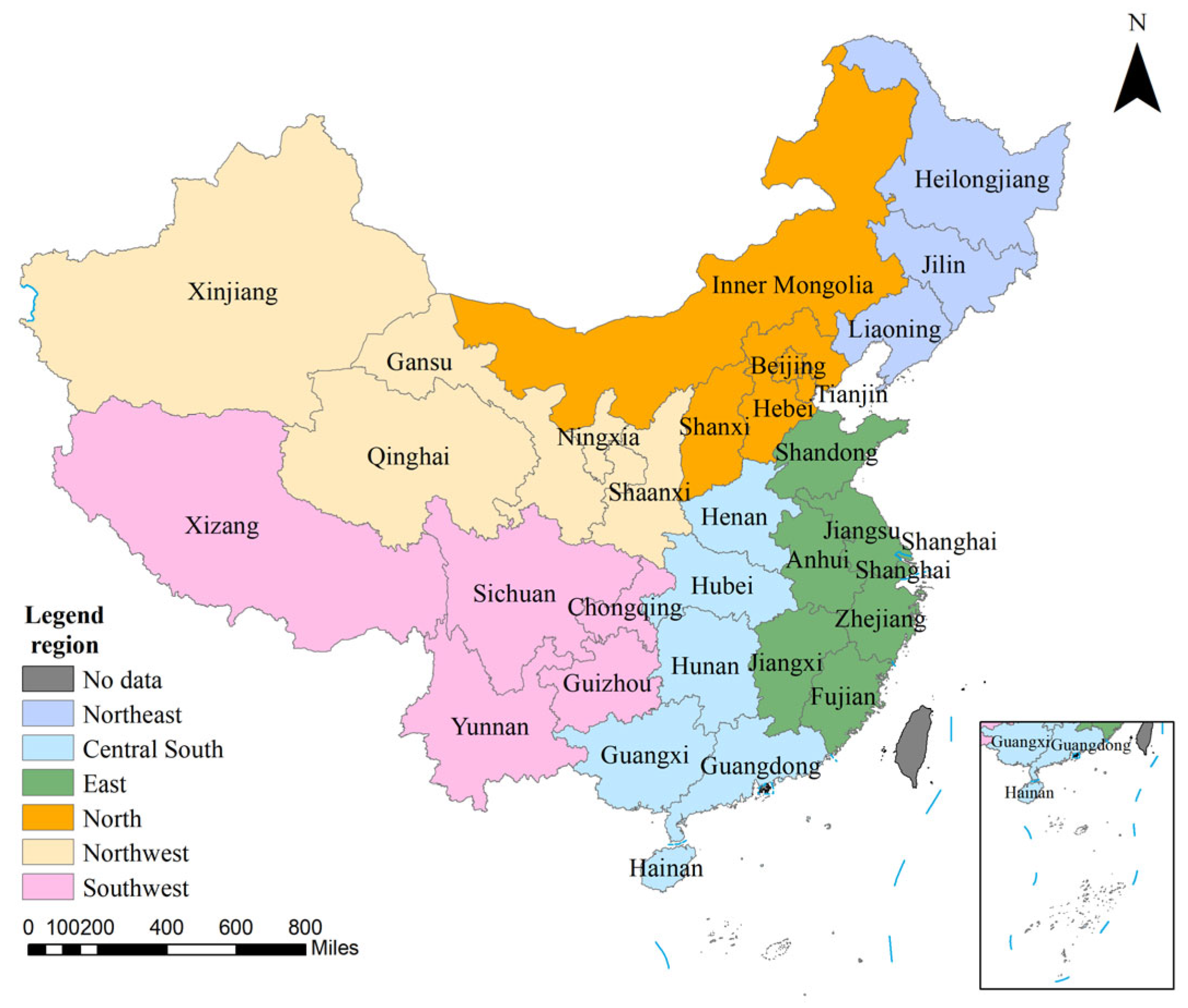
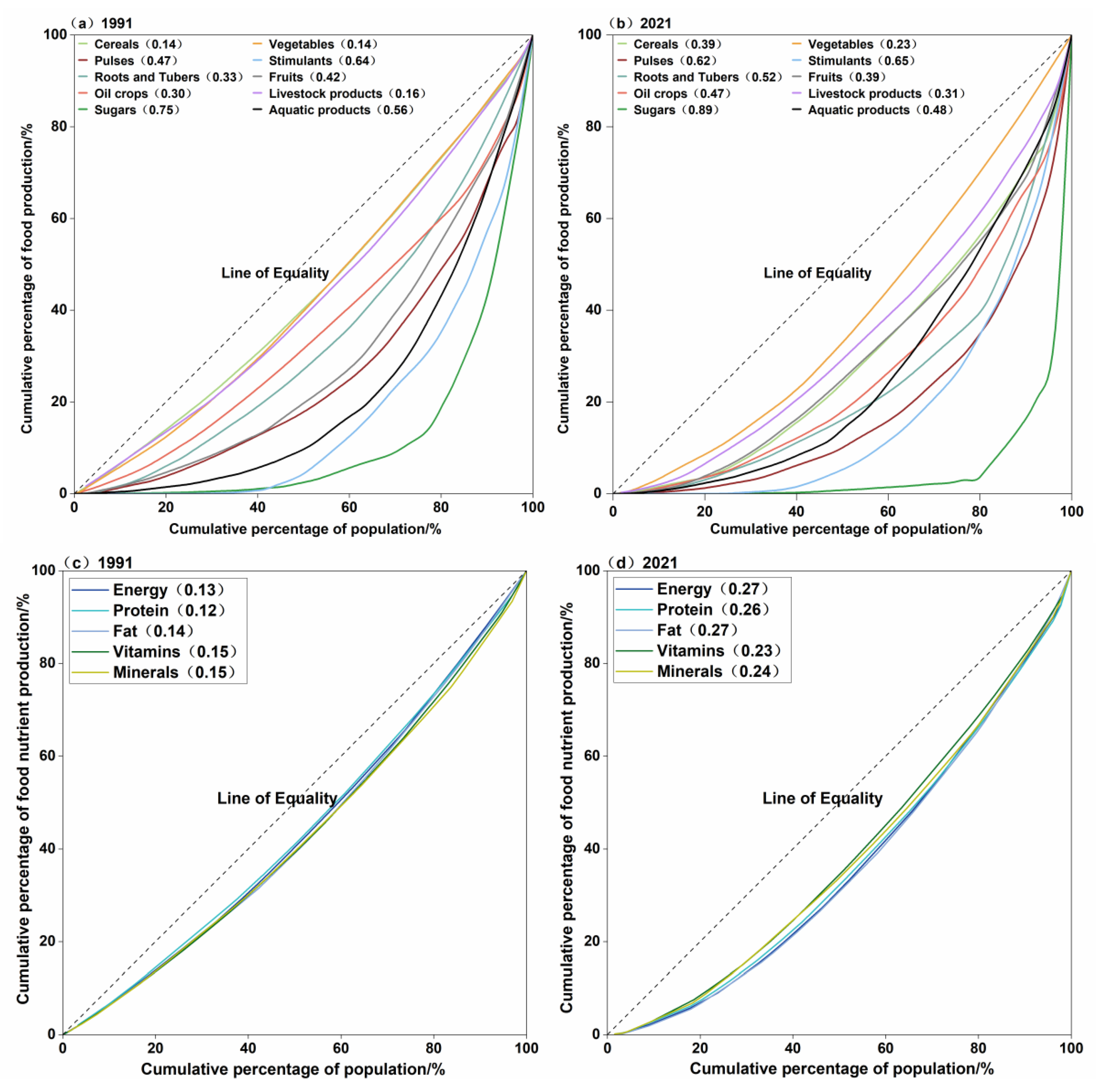
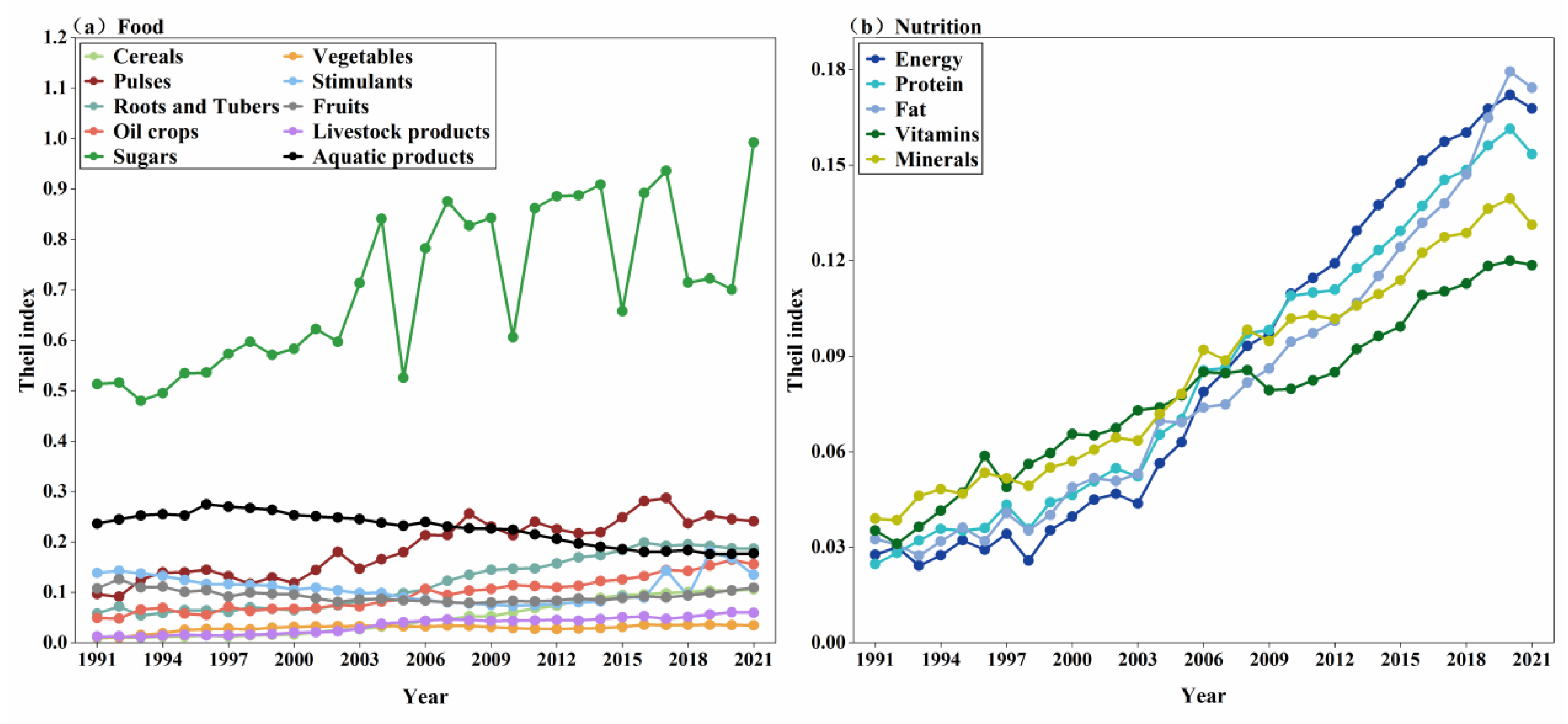
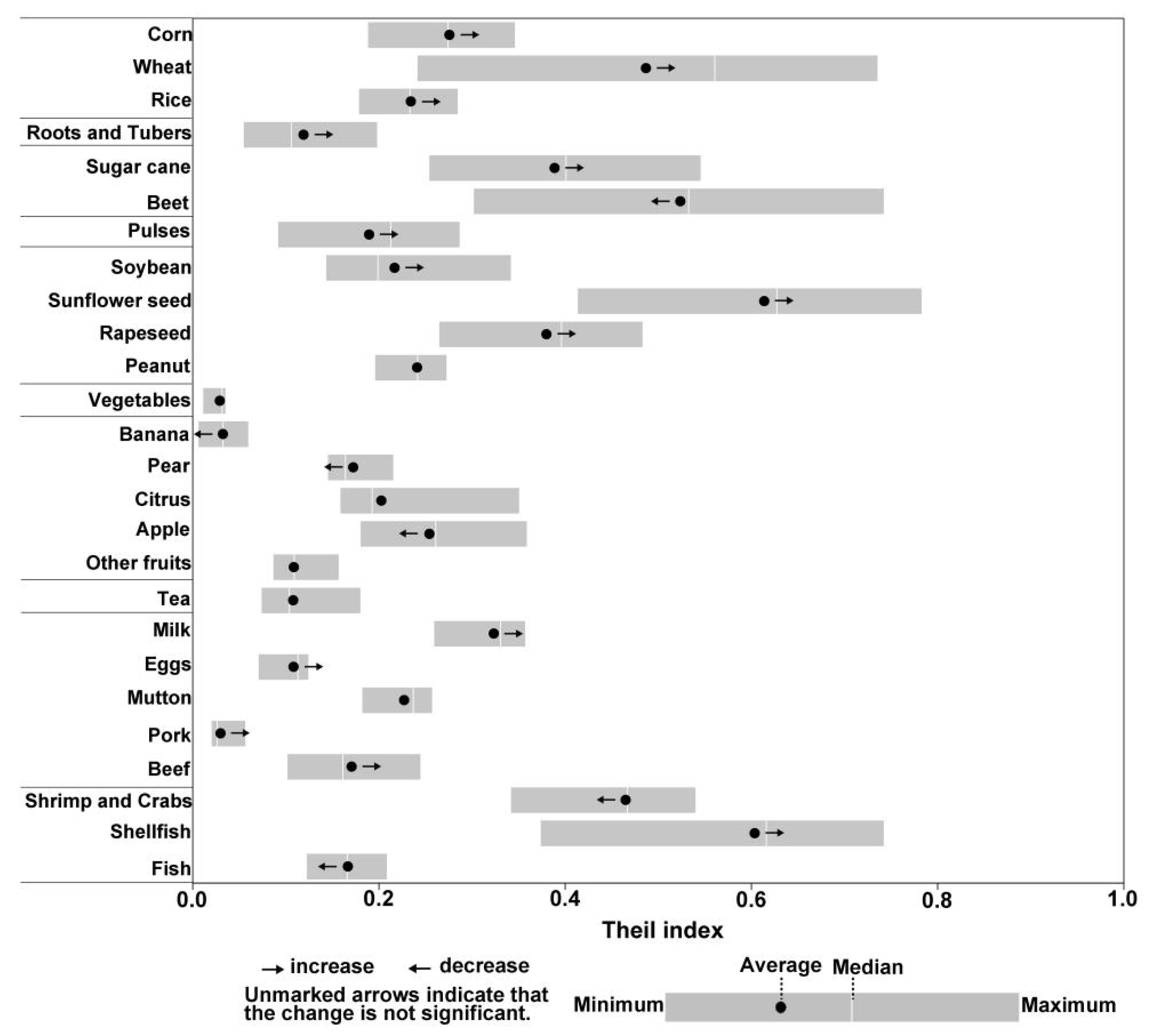
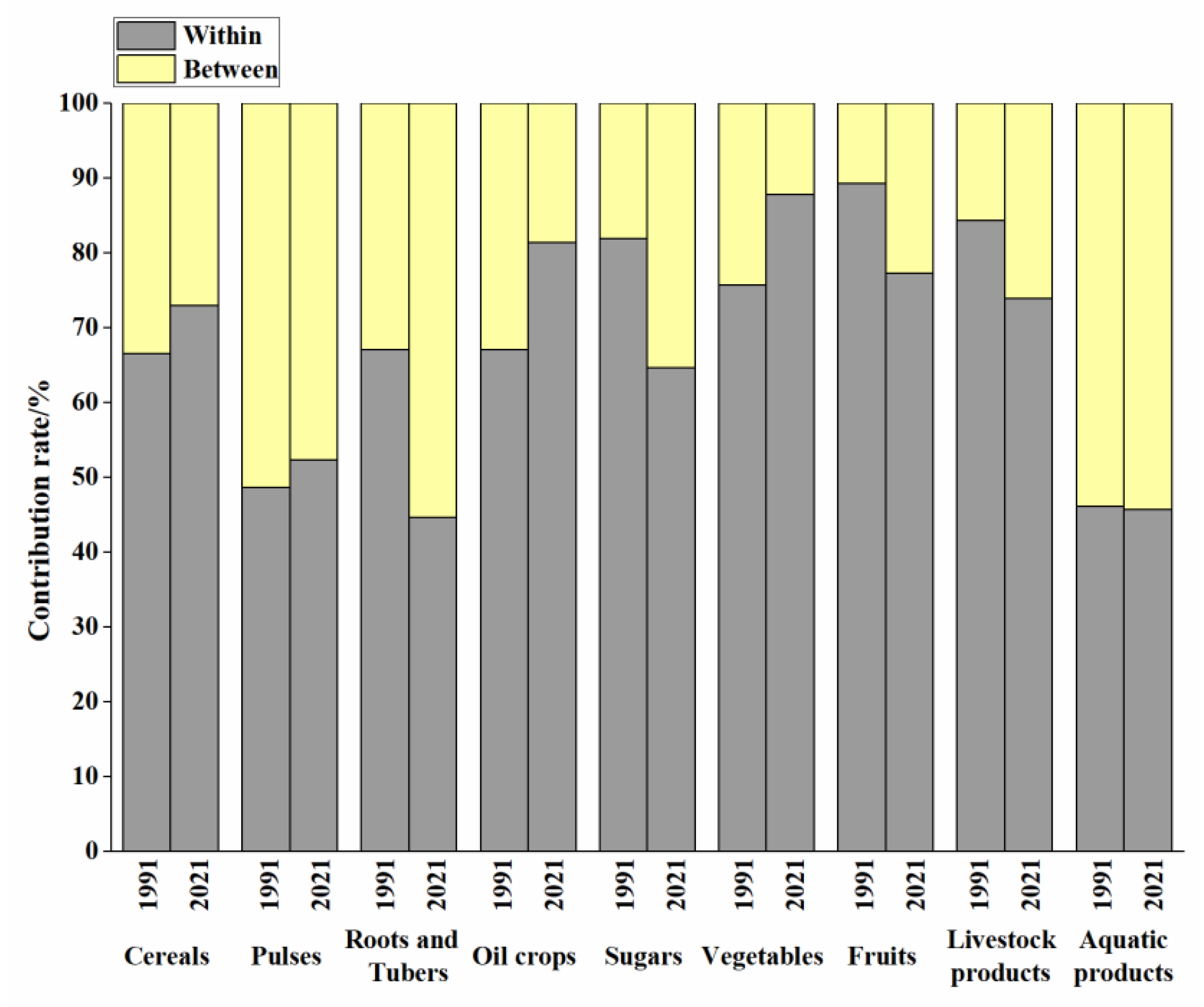
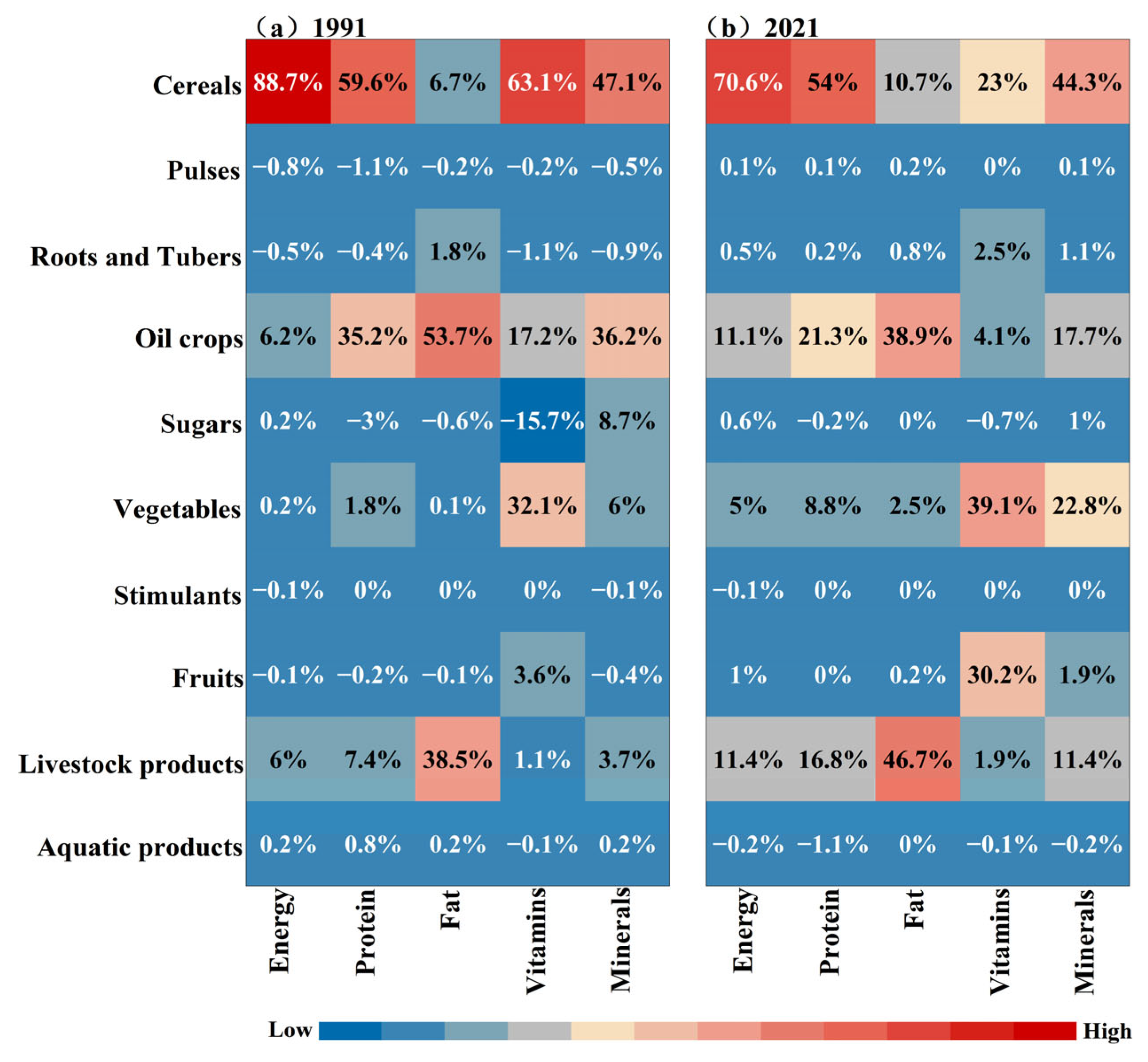
| Food Category | Food Types |
|---|---|
| Cereals | Wheat, Rice, Corn, Sorghum, Millet, Others |
| Pulses | Pulses |
| Roots and Tubers | Potatoes, Others |
| Oil crops | Soybean, Linseed, Groundnut, Sunflower seed, Rapeseed, Sesame seed |
| Sugars | Sugar cane, Sugar beet |
| Vegetables | Vegetables |
| Stimulants | Tea |
| Fruits | Apple, Pear, Date, Grape, Persimmon, Citrus, Banana, Pineapple, Others |
| Livestock products | Pork, Mutton, Beef, Poultry, Milk, Eggs, Bee honey |
| Aquatic products | Fish, Shellfish, Shrimp, Crabs |
| Energy | Protein | Fat | Vitamins | Minerals | |||||||
|---|---|---|---|---|---|---|---|---|---|---|---|
| 1991 | 2021 | 1991 | 2021 | 1991 | 2021 | 1991 | 2021 | 1991 | 2021 | ||
| Between | 30.4 | 12.0 | 21.3 | 12.5 | 24.1 | 15.6 | 34.6 | 14.4 | 31.3 | 9.8 | |
| Within | North | 7.5 | 24.2 | 7.8 | 25.4 | 10.8 | 25.6 | 4.7 | 23.8 | 5.1 | 27.5 |
| Northeast | 7.3 | 7.2 | 17.6 | 6.9 | 6.4 | 1.6 | 3.4 | 1.0 | 11.3 | 5.6 | |
| East | 18.4 | 31.9 | 21.0 | 29.3 | 7.5 | 29.8 | 33.0 | 33.9 | 28.8 | 32.7 | |
| Central South | 19.4 | 22.6 | 12.7 | 23.9 | 27.6 | 25.0 | 8.7 | 18.7 | 8.4 | 22.3 | |
| Southwest | 11.6 | 0.8 | 15.2 | 0.8 | 20.8 | 1.8 | 10.3 | 1.1 | 11.0 | 0.1 | |
| Northwest | 5.5 | 1.3 | 4.5 | 1.3 | 2.8 | 0.4 | 5.4 | 7.0 | 4.1 | 2.0 | |
Disclaimer/Publisher’s Note: The statements, opinions and data contained in all publications are solely those of the individual author(s) and contributor(s) and not of MDPI and/or the editor(s). MDPI and/or the editor(s) disclaim responsibility for any injury to people or property resulting from any ideas, methods, instructions or products referred to in the content. |
© 2025 by the authors. Licensee MDPI, Basel, Switzerland. This article is an open access article distributed under the terms and conditions of the Creative Commons Attribution (CC BY) license (https://creativecommons.org/licenses/by/4.0/).
Share and Cite
Qiang, W.; Liu, J.; Zhang, B.; Huang, D.; Xiang, Y. Inequality in China’s Food and Nutrition Production and the Decomposition of Contributing Sources. Foods 2025, 14, 3126. https://doi.org/10.3390/foods14173126
Qiang W, Liu J, Zhang B, Huang D, Xiang Y. Inequality in China’s Food and Nutrition Production and the Decomposition of Contributing Sources. Foods. 2025; 14(17):3126. https://doi.org/10.3390/foods14173126
Chicago/Turabian StyleQiang, Wenli, Jiayi Liu, Baowen Zhang, Die Huang, and Yue Xiang. 2025. "Inequality in China’s Food and Nutrition Production and the Decomposition of Contributing Sources" Foods 14, no. 17: 3126. https://doi.org/10.3390/foods14173126
APA StyleQiang, W., Liu, J., Zhang, B., Huang, D., & Xiang, Y. (2025). Inequality in China’s Food and Nutrition Production and the Decomposition of Contributing Sources. Foods, 14(17), 3126. https://doi.org/10.3390/foods14173126





